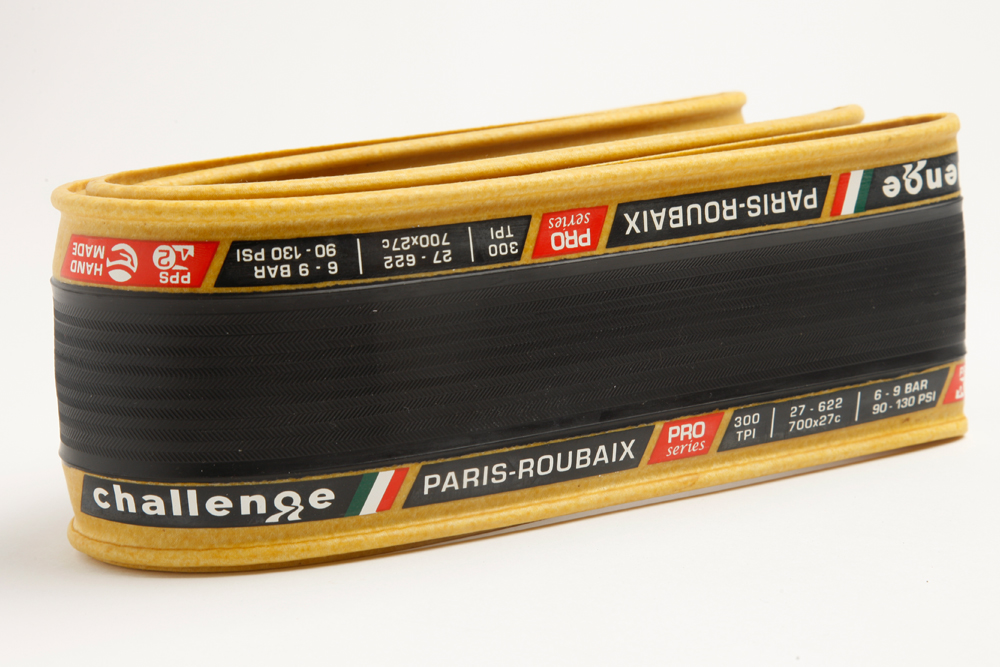Challenge Paris-Roubaix tyres review
We put Challenge's 27mm rubber through its paces

The Challenge Paris-Roubaix tyres are unsurprisingly very comfortable with their 27mm width, that only gets wider when mounted on wide rims. But they're fast too, with the open tubular construction putting the rolling resistance midways between clinchers and tubulars. The only big negative is the wet weather grip, which is an issue if you're taking in lots of steep hills in all weathers.
-
+
Low rolling resistance
-
+
Impressive comfort
-
+
Look great with tan sidewalls
-
-
Wet weather grip could be better
-
-
Pricey
You can trust Cycling Weekly.
The spring Classics might be behind us, but that doesn’t mean that I’ve stopped using the Challenge Paris-Roubaix tyres, which perform excellently and, with their tan sidewalls, add a touch of class to any bike.
While most other tyre manufacturers make multiple models of tyre, making each in a number of different widths, Challenge do things a little differently, generally assigning one width to each model of tyre. That means that you’ve got a choice of 27mm or nothing if you want a pair of Challenge tyres with Paris-Roubaix written down the side.
>>> Are wider tyres really faster?
With that 27mm width (which is actually more like 29mm or even 30mm when mounted on wide rims), it’s no surprise that the stand out feature of the Challenge Paris-Roubaix tyres. I tested them at 90-100psi on a pair of Fulcrum Quattro Carbon wheels, and they were incredibly comfortable, soaking up everything from road vibrations to sizeable potholes very effectively. Even at the end of a 200km on an aero bike that wasn’t really designed for 200km rides, my wrists weren’t aching.
Watch: buyer's guide to road bike tyres
Despite that width, these are also very fast tyres. The Challenge Paris-Roubaix tyres are neither tubulars nor clincher, but instead bridge the gap between the two with their open tubular construction. This means that they are constructed in a similar way to tubulars, with the rubber tread attached on top of a cotton casing, with the only difference being that an aramid bead is added around the outside, rather than the whole thing being sewn together with an inner tube in the middle.
>>> How to puncture proof your tyres (video)
The latest race content, interviews, features, reviews and expert buying guides, direct to your inbox!
This produces a tyre that can’t quite match the low rolling resistance and suppleness of a tubular, but is certainly much faster and smoother than what you’d expect from a 27mm standard clincher. The only downside of this is that the tyre comes out of the package flat, which means that it can be awkward to fit, particularly on a narrow rim.

Puncture protection is always a tough thing to judge when testing a pair of tyres, and I can’t be sure whether the fact that I didn’t get any punctures when using the Challenge Paris-Roubaix tyres was down to the two layers of Challenge’s Puncture Protection Strip positioned down the centre of the tyre, or just through pure luck.
>>> Buyer's guide to road bike tyres (video)
However, one thing that I certainly wasn’t convinced by was the Challenge Paris-Roubaix tyres’ performance in the wet. With water on the road on gradients of anything over 10% and you these tyres really force you to stay in the saddle in order to maintain rear wheel traction. The only positive to come from this was that it gave me an excuse to avoid steep hills!
The only other possible downside is the price, which, at £54 per tyre, is a little on the high side. But then again if you’re after a very comfortable, fast, and good-looking summer tyre, then maybe that’s the price you’ve got to pay.
Henry Robertshaw began his time at Cycling Weekly working with the tech team, writing reviews, buying guides and appearing in videos advising on how to dress for the seasons. He later moved over to the news team, where his work focused on the professional peloton as well as legislation and provision for cycling. He's since moved his career in a new direction, with a role at the Department for Environment, Food and Rural Affairs.